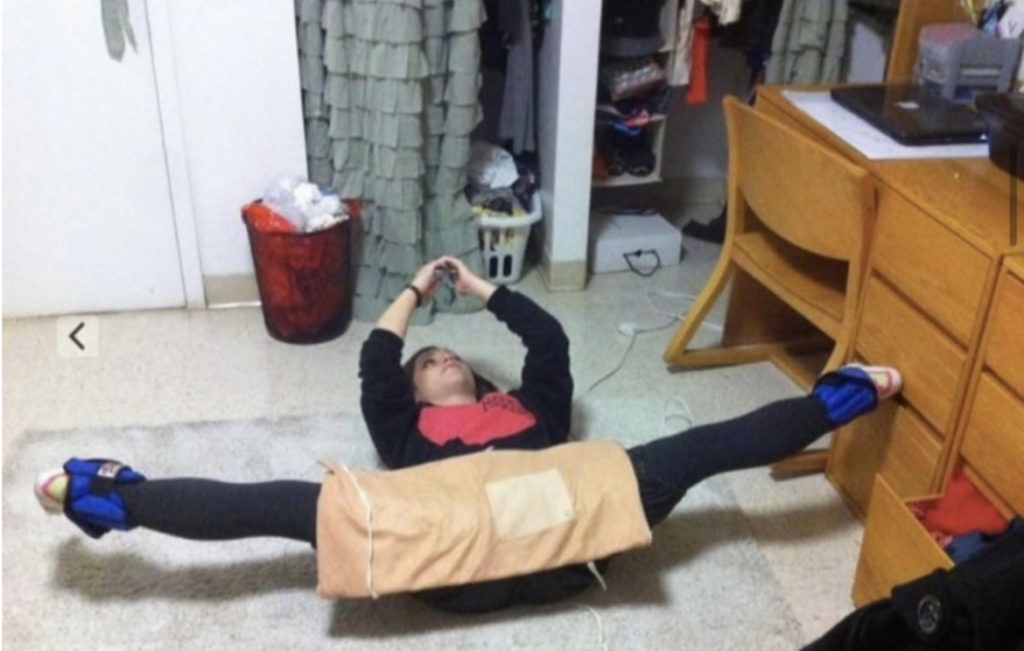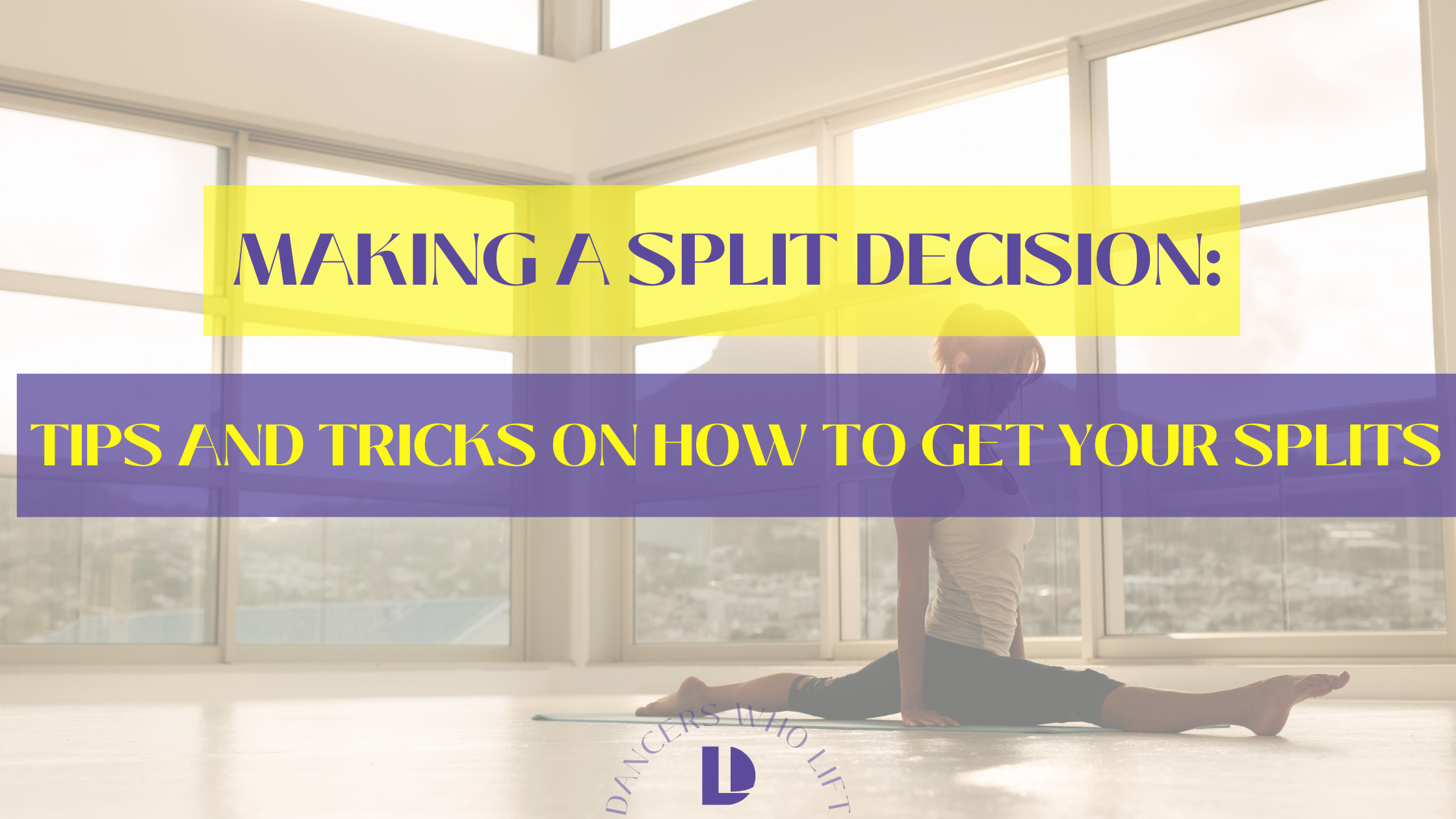If you’re not naturally flexible as a young dancer, learning how to get your splits can be a frustrating process. Unlike learning how to pirouette or tendu, learning how to get your splits requires that you do a great deal of mobility work prior to attempting the move.
What’s more, there is tons of misinformation out there about the best ways to achieve this goal.
How many of you have done a wall split?
What about laying on your back in a straddle with ankle weights on?
Or, for my over split attempters, how many of you have hung out with your front or back leg up on a stack of books?
Don’t feel badly! A lot of us have been the victims of inadequate stretching techniques. And that’s exactly what they are, stretching techniques.

Do they work?
Well, let’s just say they do help extend your flexibility, but they do very little for mobility.
What’s the difference? Check out this quick read for a full explanation.
But on the basic level, flexibility is how far a muscle group can passively lengthen (think laying on your back and pulling your leg to your face). While mobility is the degree to which a joint can move through its range of motion without influence of an outside force (your arms) or momentum (battement momentum).
The difference between these two is why many dancers are able to stretch their legs up to their ears, but when it’s time for adagio they’re left yearning for that extra 20-40% of extension.
What does all of this have to do with getting your splits?
I’m so glad you asked!
The splits are something dancers use both to increase their flexibility and as a position utilizied in choreography. So learning how to get your splits is important.
But wouldn’t it be great if learning how to get your splits, also involved increasing your mobility as well as your flexibility?
Working through your splits with dynamic stretching will not only increase your flexibility but it will also build strength through your end range of motion, increasing the control you will have working through that position.
Using this dynamic flow as a part of your warm-up will help increase your range of motion while enhancing your muscle force. Unfortunately, just sitting in your splits before an audition, could actually decrease the amount of power and control you might have when it’s time to dance.
Adding dynamic stretching into your toolkit as a dancer will certainly transform your end range of motion mobility.
This dynamic stretching flow is an excellent tool used for how to get your splits.
Let’s dive in!
-
Good Mornings
Good mornings are an excellent way to simply wake up the hip joint.
Stand with your feel hip width apart, knees soft. Lengthen your spine, bracing your abdominals. Then, slowly, hinge your hips backward while maintaining a flat back position. Continue to hinge until you feel a stretch in the backs of your legs. Push the hips forward to return to your starting position. Repeat 5-8 reps.
-
Hamstring hinge
These hamstring hinges will not only test your stability, but they are a great way to increase your hamstring range of motion!
Stand with your feet together and extend one leg out in front of you with your foot flexed. Lengthen your spine, bracing your abdominals.
Bend your standing leg as you ing your hips backward, sweeping the floor with your arms as they reach down to the ground, then out toward your extended leg.
The end of the sweep should return you to a standing position.
Repeat 6-8 reps.
-
Kneeling hip tuck
This one never ceases to surprise me. (If you have cranky knees, grab a pillow or towel to use as a cushion)
Take a knee as if you are about to be knighted! Place your hands on your hips and lengthen your spine. Gently tuck your pelvis, as if you are trying to pull your hip bones toward your belly button. Slowly, extend, returning to a neutral position.
Repeat this for 6-8 reps.
-
Kneeling hamstring slide with hip hinge
For the kneeling hamstring slide, you may want to place your hand on a coffee table or yoga block for added stability.
In the same kneeling position as the kneeling hip tuck, extend your front leg straight with your foot flexed.
Now, imagine there are headlights on your hip bones, throughout this exercise, you want to ensure your headlights are both facing forward.
With one hand resting on a yoga block or table, place the other on your hip.
Keeping your spine tall push your hips forward and slide the leg out until you feel a gentle stretch. Then, keeping your spine long and abs braced, pull your hips back. This should put you into a pseudo child’s pose position with your front leg still extended.
Then, slowly return to your starting position.
Repeat this for 8-10 reps, getting deeper into your extension each rep.
-
Kneeling hamstring slide
This is almost exactly the same as the previous exercise with one main difference. For this move instead of hinging into an extended childs pose at the base of your extension, you will instead engage your glutes, abductors, and adductors and slide back up in your starting position.
Engaging your abdominals will help you immensely when working through this move!
Repeat until you slide all the way into your full split. (Do not try and reverse slide out of a full split! That’s a trick for another day!)
-
Repeat entire flow on opposite side
Now that you’ve opened up one side, it’s time to repeat the entire flow on the other side!
So, give this a try and let us know how it goes! Did it help you get your splits? Did it get you deeper into your splits than before? Did you notice a difference in your range of motion in class? Tell us all about it in the comments We want to celebrate your wins with you!
Tag us in the flow @dancerswholift on instagram or Tiktok!

